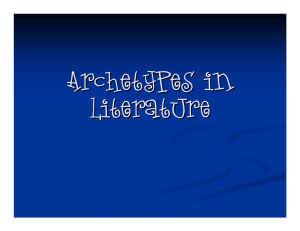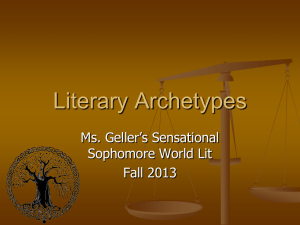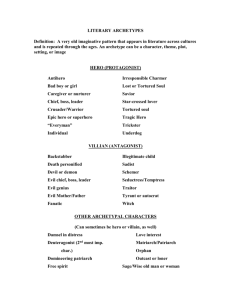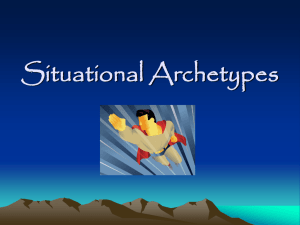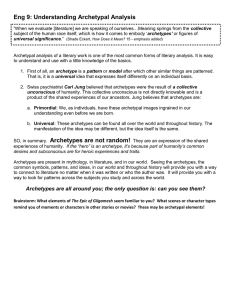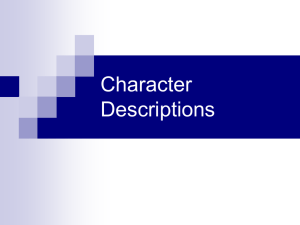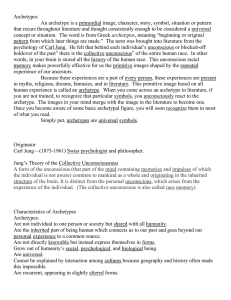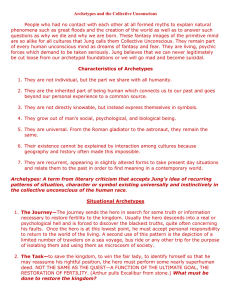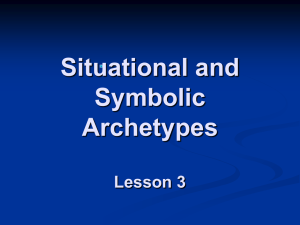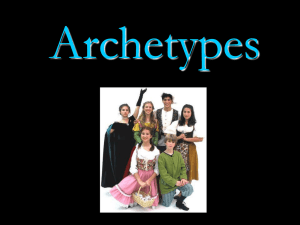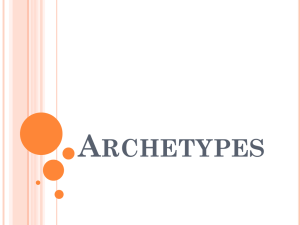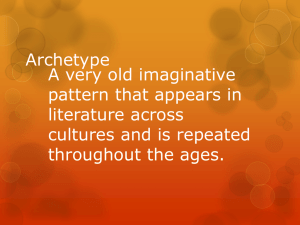the innocent - Ms. Garrison
advertisement
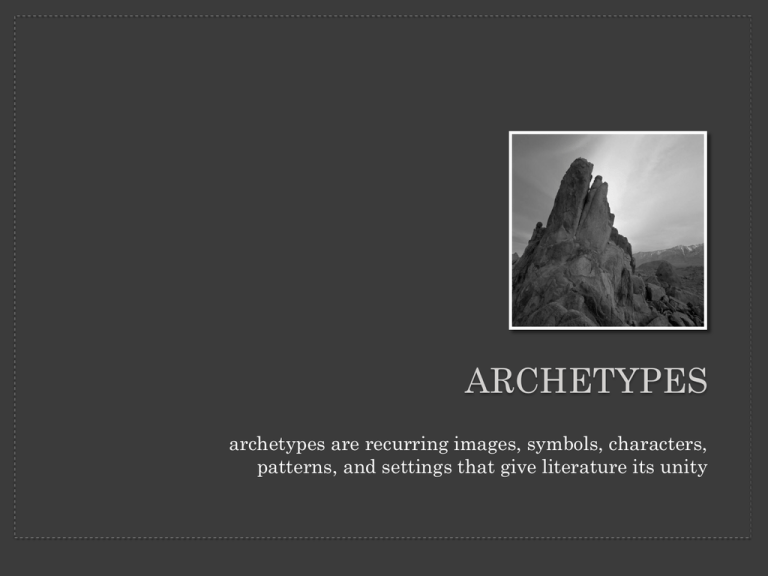
ARCHETYPES archetypes are recurring images, symbols, characters, patterns, and settings that give literature its unity What are common characteristics of archetypes? •Commonality with all humanity •Part of people that connect them to their past, beyond personal feeling to a common experience •Not especially knowable, but express themselves in forms •Universal, understood by everyone •Recurring, change with modern times, relate them to the past in order to find meaning in a contemporary world ARCHETYPAL CHARACTERS THE HERO portrayed as “larger than life.” exhibits outstanding qualities and abilities. embodies the ideals of his/her culture and society. Essence of hero is self-sacrifice Will endure separation and hardship for his/her clan Must a pay a price to achieve goal.; he/she changes Must leave “ordinary world” into the “unknown”; Comes back changed Must return and spread new knowledge, but does not have to stay THE ANTI-HERO • Reluctant hero who does not consider himself capable of accomplishing the goal • Might be selfish, addicted, corrupt, sullen or disaffected • Not afraid to bend or break the law in the belief that “the ends justify the means” • By the end of the journey: typically transforms into a fuller, happier or more complete person because of struggles • In many cases, he/she dies at the end, even while overcoming THE VILLAIN •Also known in film and literature as the "bad guy", “black hat", or "heavy” •An “evil" character in a story •Usually the antagonist, tends to have a negative effect on other characters •Female villain is sometimes called a villainess (often to differentiate her from a male villain) •Usually a cruelly malicious person who is involved in or devoted to wickedness or crime •Constitutes an important evil agency in the plot THE WISE OLD MAN Usually a profound philosopher distinguished for wisdom and sound judgment. These characters many times have beards. THE DAMSEL IN DISTRESS •Classic theme in world literature, art, and film •Usually a beautiful young woman placed in a dire predicament by a villain or a monster •Requires a hero to dash to her rescue THE SHREW • A woman who is excessively unpleasant • Prone to temper tantrums and emotional and psychological warfare Verbally and sometimes physically abusive • Insists on imposing her will on everyone and is willing to take extreme measures to get her way • Dominates her relationships, especially the one with her weaker willed husband THE INNOCENT • Promised that life need not be hard • A child or a naïve/inexperienced person who is exposed to the evil in the world • Usually moves from innocence to experience and knowledge THE HELPFUL ANIMAL Any animal that helps the hero in times of trouble. The animal can be a sidekick that offers reason to the hero when he gets stuck and can’t figure his way out. ALTER-EGO OR DOUBLE Split personalities or opposite tendencies within one individual EARTH MOTHER The eternal provider: protecting, nurturing, sheltering, nourishing female character THE TEMPTRESS A woman, who through her power, can render a strong man weak and a wise man foolish. OPPOSITES OR COMPLIMENTARY PAIRS Two individuals of opposite natures who, if combined, would make one balanced and “complete” individual. SCAPEGOAT OR SACRIFICIAL VICTIM One who suffers or is blamed unjustly in order that others may escape blame or punishment. THE TRICKSTER In mythology, folklore, and religion, a trickster is a god, goddess, spirit, man, woman, or anthropomorphic animal who plays tricks or otherwise disobeys normal rules and conventional behavior. THE UNFAITHFUL WIFE A woman married to a man she sees as dull or distant and is attracted to a more virile and interesting man. Archetypal Settings The Garden Cultivated and carefully planned. Restricted to certain vegetation. Represents order. The Forest/The Countryside • Habitat of the Great Mother (Mother Nature), the lunar force • Fertility • Mother Nature sustains vegetation and animals in this “green world” • Symbolically, primitive levels of the feminine psyche, protective and sheltering • Those who enter often lose their direction or rational outlook and thus tap into their collective unconscious • Opposite of the cultivated gardens The Tree Represents life and knowledge Mountains and Peaks Highest peak is place to “see” far Place to gain great insight The Cave • Deep down where the character delves within themselves • Place that the character goes when “invisible” or inactive • At the extreme may signify death The River • • • Crossing may symbolize new territory Boundaries or borders with something new or different on either side May represent human life or time passing May represent death and rebirth (baptism) The Sea • Vast, alien, dangerous, chaos • Waves may symbolize measures of time and represent eternity or infinity • Mother of all life • The unconscious The Fountain • Stands for purification • Sprinkling of water (baptism) washes away sin • Water of fountain gives new life Islands Microcosms or small worlds unto themselves Represent isolation or get-a-ways Archetypal Symbols The Sun • • • • • • Fire and Sky are closely related Creative energy Law in nature; consciousness (thinking, enlightenment, wisdom) Passage of time and life Rising sun: birth; creation; enlightenment Setting sun: death Colors Red: blood, sacrifice, violent passion, disorder Green: growth, sensation, hope, fertility Blue: highly positive, truth, religious feeling, spiritual purity, security White: light, purity, innocence, supernatural Black: chaos, mystery, the unknown, death, evil The Circle Sphere: wholeness Egg (oval) the mystery of life and the forces of the generation Yang-Yin • Chinese symbol representing union of opposite forces • Male vs. Female Ouroboros • The ancient symbol of the snake biting its own tail • Represents the circle of life Serpent • Snake or worm • Symbol of energy and pure force; evil; corruption; sensuality; destruction; mystery; wisdom; the unconscious Numbers (Western Culture) Three: light; spiritual awareness and unity (The holy Trinity); the male principle Four: associated with the circle; life cycle; four seasons; female principle, earth, nature; four elements (earth, air, fire, water) Seven: the most potent of all symbolic numbers – signifies the union of three and four; the perfect order Twelve: The completed heavenly cycle Thirteen: Betrayal, death, negativity; except in Native American culture where the number is sacred Light vs Darkness • Light usually suggests hope, renewal, or intellectual illumination • Darkness implies the unknown, ignorance or despair Water vs Desert • Water appears as birth or rebirth • Desert appears as lack of life or death Heaven vs Hell Heaven: the sky and mountain tops house the gods Hell: the bowels of the earth contain the diabolical force that inhabits this universe Supernatural Intervention The gods intervene on the side of or sometimes against the hero Fire vs Ice • Fire represents light, life, rebirth • Ice represents ignorance, darkness, sterility Situational Archetypes The Quest GET SOMETHING! The search for someone or some talisman which, when found and brought back, will restore life to a wasted land, the lifelessness is mirrored by the leader’s illness and disability. The Task DO SOMETHING! • to save the kingdom • to win the fair lady • to identify himself so he may reassume his rightful position • …the hero must perform a superhuman deed The Journey LEARN SOMETHING! Sends the hero in search of some truth or information necessary to restore fertility to the kingdom. The Fall • Descent from a higher to a lower state of being • Involves a loss of innocence The Unhealable Wound • A wound that will not fully heal • Indicates a loss of innocence, whether physical or psychological Archetypal Motifs and Themes Forbidden Love/Star-Crossed Lovers • A phrase describing a pair of lovers whose relationship is often thwarted by outside forces • Encompasses other meanings but originally means the pairing is being "thwarted by a malign star" or that the stars are working against the relationship Rags to Riches/Transformation refers to any situation in which a person rises from poverty to wealth, or sometimes from obscurity to fame The Wicked Stepmother • Persecutes the child left behind after the father dies, leading to conflict • Serves to support the motif of glorified motherhood and the theme that nonmaternal women are dangerous Guilt and Redemption • A character is burdened with terrible guilt for a real or perceived sin and attempts to atone for his mistakes and achieve spiritual redemption. Often requires a heroic act, a sacrifice, or a fall from grace before the character can be redeemed Love Conquers All Despite obstacles and opponents, in the end love is an indestructible force, whether for good or for harm. Pride Goes Before a Fall This theme reminds readers/viewers that pride, or hubris, is an offense that will be punished. What goes around comes around. Theme that reminds us that wrongdoing will be returned one way or another.
